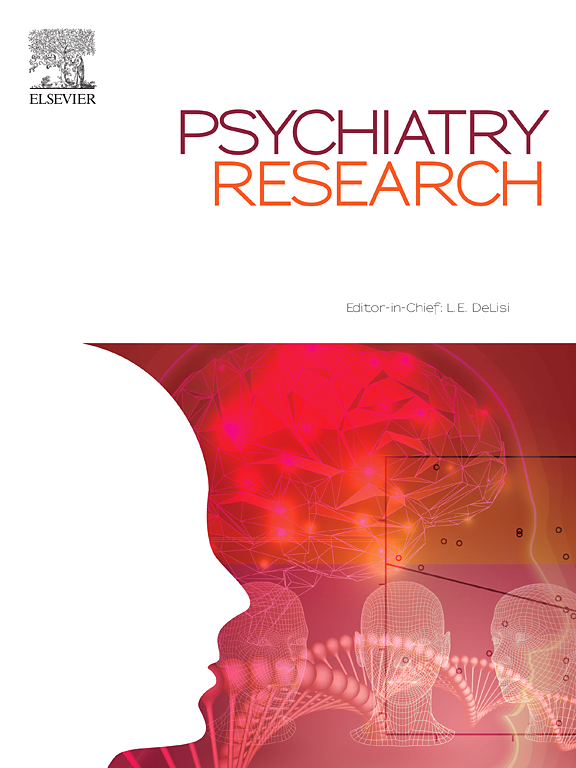Obsessive-compulsive disorder with hoarding behavior: unravelling key differences
IF 3.9
2区 医学
Q1 PSYCHIATRY
引用次数: 0
Abstract
Objective
Hoarding disorder remains underexplored and poorly understood despite its significant impact on individuals and communities. While historically linked to obsessive-compulsive disorder (OCD), emerging evidence suggests they may be distinct conditions. This study aims to investigate these differences.
Methods
Adults aged 18–88 years old (M = 39.86, SD = 14.86) were part of the Genomic Psychiatry Cohort study, including 1247 individuals with OCD without presumed hoarding disorder (OCD-pHD) and 663 individuals with OCD and presumed hoarding disorder (OCD+pHD). Sociodemographic data were collected, and participants were screened for other psychiatric conditions. All met DSM-5 criteria for OCD, with severity assessed using the Florida Obsessive-Compulsive Inventory and Y-BOCS. Statistical significance was set at p ≤ 0.0007, adjusted for multiple comparisons.
Results
The OCD+pHD group had significantly lower educational attainment, was more likely to live alone or in supervised living, and less likely to be married. This group also had more severe OCD and poorer insight. All types of obsessions and compulsions were more frequent in the OCD+pHD group, except for obsessions related to harming others. Additionally, the OCD+pHD group had higher rates of major depressive disorder, post-traumatic stress disorder, bipolar disorder, schizophrenia, body dysmorphic disorder, trichotillomania and previous diagnosis and/or symptoms of attention deficit and hyperactivity disorder. No significant difference was found for substance use and Tic/Tourette disorders.
Conclusions
Significant clinical differences were observed between the groups, highlighting the need for further research to improve diagnosis, conceptualization, awareness, and support for individuals with hoarding disorder in the context of OCD.
强迫症与囤积行为:揭示关键差异
尽管囤积症对个人和社区产生了重大影响,但它仍未得到充分的探索和了解。虽然历史上与强迫症(OCD)有关,但新出现的证据表明,它们可能是不同的疾病。本研究旨在调查这些差异。方法18 ~ 88岁成人(M = 39.86, SD = 14.86)加入基因组精神病学队列研究,包括1247例无推定囤积障碍(OCD-pHD)的强迫症患者和663例合并推定囤积障碍(OCD+pHD)的强迫症患者。收集了社会人口统计数据,并对参与者进行了其他精神疾病的筛查。所有人都符合DSM-5强迫症的标准,并使用佛罗里达强迫症量表和Y-BOCS来评估其严重程度。经多次比较调整后,p≤0.0007为统计学显著性。结果强迫症+博士组受教育程度明显较低,独居或有人监督生活的可能性较大,结婚的可能性较小。这组人也有更严重的强迫症和更差的洞察力。除了与伤害他人有关的强迫行为外,所有类型的强迫行为在OCD+pHD组中都更为频繁。此外,强迫症+博士组有较高比例的严重抑郁症、创伤后应激障碍、双相情感障碍、精神分裂症、身体畸形障碍、拔毛癖和先前的诊断和/或注意缺陷和多动障碍的症状。在药物使用和抽动/抽动秽语障碍方面没有发现显著差异。结论两组之间存在显著的临床差异,需要进一步研究以提高对强迫症背景下囤积障碍患者的诊断、概念化、认识和支持。
本文章由计算机程序翻译,如有差异,请以英文原文为准。
求助全文
约1分钟内获得全文
求助全文
来源期刊

Psychiatry Research
医学-精神病学
CiteScore
17.40
自引率
1.80%
发文量
527
审稿时长
57 days
期刊介绍:
Psychiatry Research offers swift publication of comprehensive research reports and reviews within the field of psychiatry.
The scope of the journal encompasses:
Biochemical, physiological, neuroanatomic, genetic, neurocognitive, and psychosocial determinants of psychiatric disorders.
Diagnostic assessments of psychiatric disorders.
Evaluations that pursue hypotheses about the cause or causes of psychiatric diseases.
Evaluations of pharmacologic and non-pharmacologic psychiatric treatments.
Basic neuroscience studies related to animal or neurochemical models for psychiatric disorders.
Methodological advances, such as instrumentation, clinical scales, and assays directly applicable to psychiatric research.
 求助内容:
求助内容: 应助结果提醒方式:
应助结果提醒方式:


